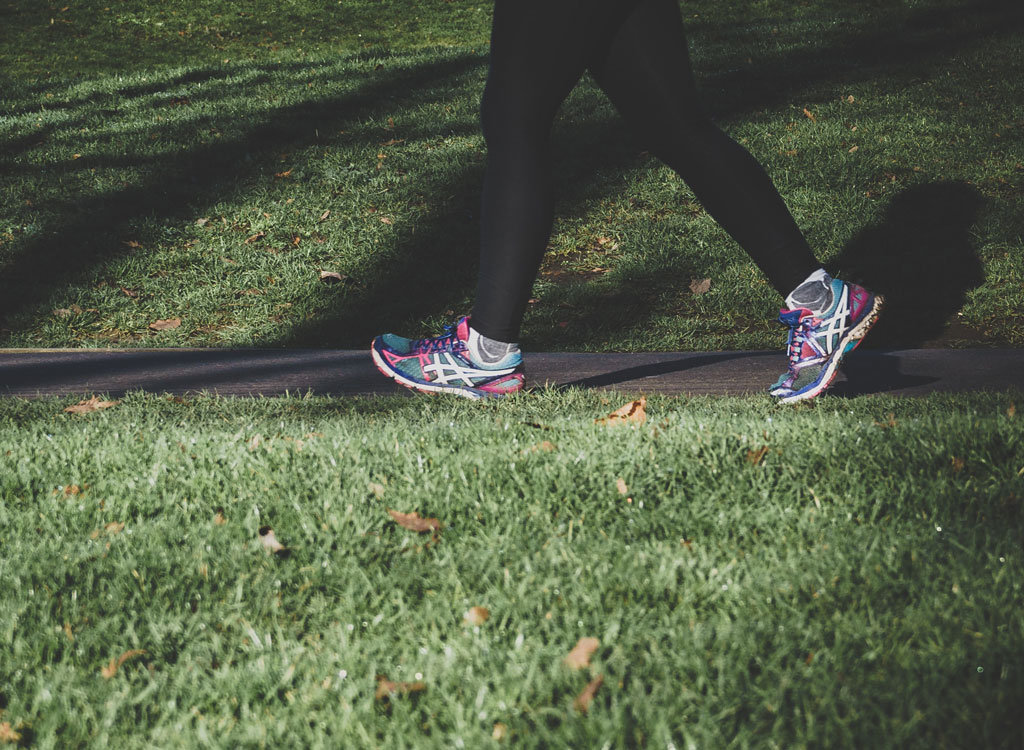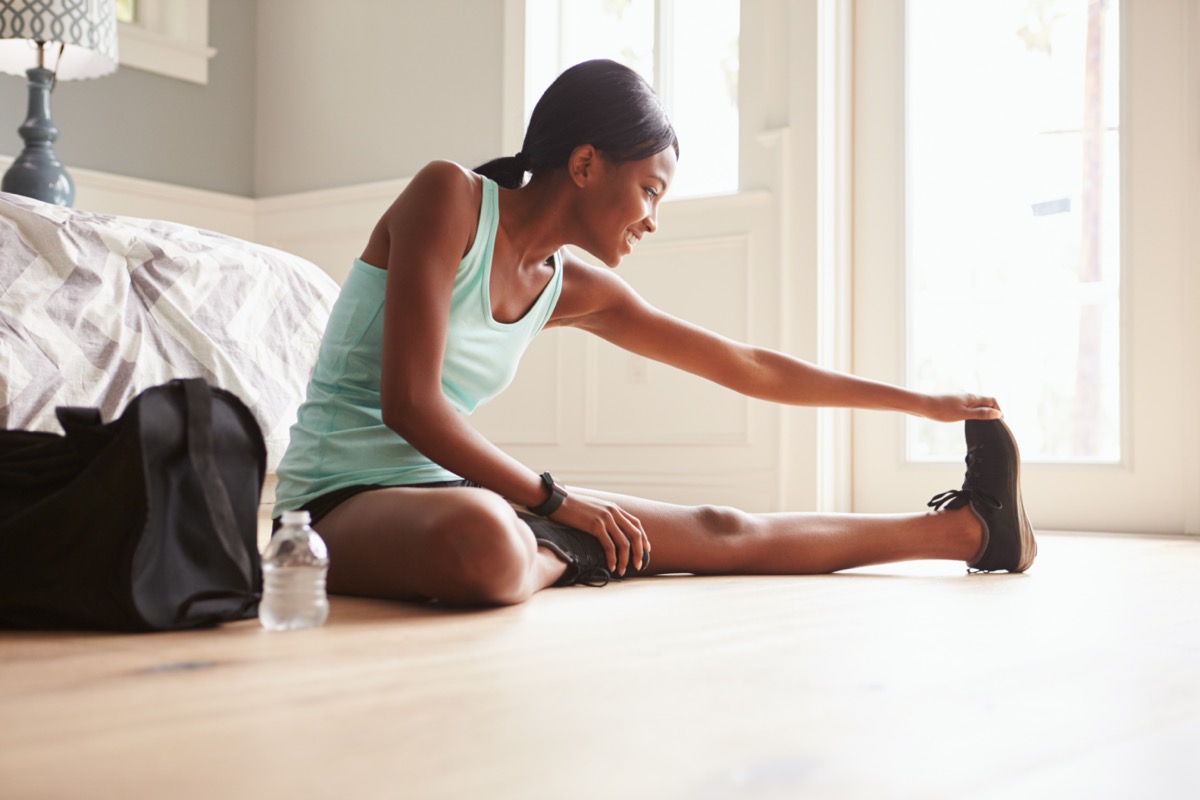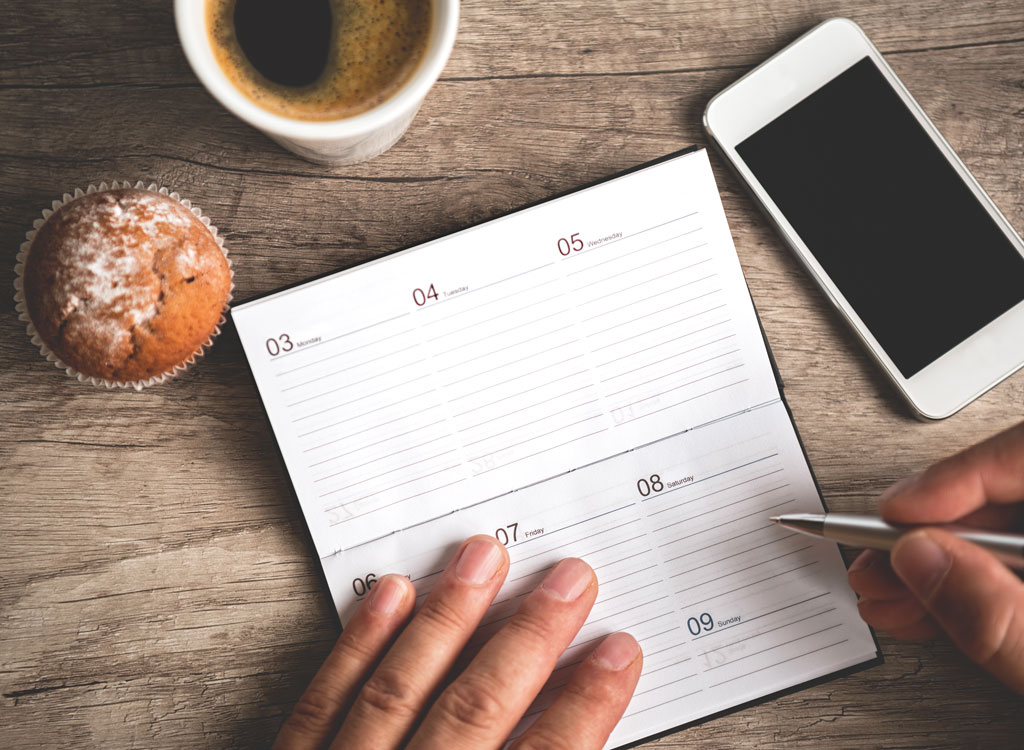40 Ways to Get Back in Shape

Sometimes life can pull you in a million different directions, all of which make you avoid exercise. And you know what, that's A-OK! We all need the occasional hiatus. But getting back in shape doesn't have to be dread-worthy, either. In fact, easing into a regular fitness routine—just one small step at a time—will help move you along the road to fit and healthy. To help you get to a place where you can finally put that first foot forward, we spoke to fitness pros who offer the best ways to get back in shape and reignite your active lifestyle. Follow their advice, and don't forget to celebrate all the small successes along the way. And for more ways to stay in shape, here are 21 Ways to Sneak In a Workout While You're Waiting For Your Food Delivery.
Be SMART with goal setting.

SMART stands for specific, measurable, attainable, relevant, and timely. "As you re-start exercise after your workout hiatus, remember to be kind to yourself and set reasonable goals," says Rachelle Reed, PhD, CPT, Pure Barre's manager of training development and barre kinesiologist. "Rather than jumping in head-first, start slowly." Write down those goals so you can check back on them in a month or two, too.
Mark it on your calendar.

Add your workouts to your schedule—in pen, Reed suggests. Aim for two to three workout days to start, and map out those days on Sunday before the week kicks off and gets jam-packed. "Showing up to the time you've blocked out for yourself may be one of the best parts of your day," Reed says.
And for more ways to stay healthy, don't miss these Top 15 Nutrition Tips During Quarantine.
Get up from your desk.

You've probably heard that sitting isn't so good for you, so plan to move more throughout the day. Reed recommends three ways to do that: take a 10-minute walk on your lunch break, schedule a walking meeting with a coworker, or stretch it out in the bathroom for just five minutes mid-afternoon.
Choose on-demand videos.

You can find tons of videos—either free on YouTube or via a subscription-based plan on sites like NEOU fitness, Daily Burn, or Obe Fitness. Try out a few of the 20- to 30-minute sequences and see what you like and want to go back and do again. The best part is that you don't even have to leave your living room. Press "play" before or after dinner, when your family goes to bed, or when they're still sleeping in the morning, and you'll have a few minutes for yourself to get moving, says Reed.
Take the long way.

You can never go wrong with parking farther away from the grocery store, skipping the elevator and taking the stairs, or going a few extra blocks to the bank. The small increases in your daily step count can lead to big results, Reed says.
And for more ideas, don't miss these 30 Tips When You're Walking for Weight Loss.
Fuel up for better fitness.

To push to your physical peak, you need to eat right and drink plenty of water, says Amy Opielowski, CSCS, a master trainer at CorePower Yoga. She recommends consuming half your body weight in ounces of water, eating a rainbow of colors, and mixing protein, carbs, and healthy fats in every meal to keep you full enough to work out and build muscle.
Have a workout snack.

Find three times throughout your day to have a quick healthy snack and then schedule your workouts around it. All you need is two minutes to hit a round of jumping jacks, burpees, squats, push-ups—or all four, says Opielowski. Time it right before a food snack as a reminder to squeeze it in.
Need some ideas? Try one of these 16 Post-Workout Snacks Fitness Experts Swear By.
Do bodyweight intervals.

You can do moves like squats, lunges, and mountain climbers anywhere and everywhere, so pick your favorite spot and just start stepping. Go for 30 seconds, then rest for 10 seconds and repeat for as many rounds as possible, says Opielowski.
Breathe it out.

After your workout, take a second to pause, stretch, and breathe into your body, suggests Opielowski. This not only helps the body cool down and soothes your neuromuscular system, but it'll also give you another moment to de-stress from your day.
Check your soreness.

Restarting a workout routine shouldn't leave you so sore that you can't walk, says Kate Ligler, CPT and MINDBODY wellness manager. Otherwise, that might turn you off from getting your sweat on again. If you've been pretty sedentary, consider starting with just 10 minutes of stair climbing.
Find your support system.

"Who supports you? Who is going to ask if you got up to work out, even when every iota of your being wants to sleep in? Whether it's a loved one, a close friend, or a co-worker, lean into your team who will support you in your new workout routine—rain or shine," says Ligler. There's power in numbers.
Make it public.

Sometimes sharing your goals with the world makes you more likely to keep reaching for them, so don't be afraid to post about your new movement habits and ambitions on social media or tell your friends and family about it in person, suggests Ligler.
Rethink your week.

Just like you should set up your week for success on a Sunday, you should reflect on the past week and do a little assessment of your success. If you stuck to your schedule and feel good, build on that. If you found it hard to follow what you set out to accomplish, then readjust. There's no shame in setting a new list of goals each week, says Ligler.
Give yourself freedom.

"Flexibility and course corrections are both a necessary and realistic part of life," says Ligler. "Missing one workout won't derail your plan, but missing multiple workouts in a week is a slippery slope." If you do end up skipping out on a bunch of sweat times, then adjust your plan or consider a new activity—or even start a little smaller, creating a tiny new habit first.
Answer your 'why?'

When you feel your workout motivation weaning—or even before that happens—ask yourself why it's so important to you to get back to a regular exercise routine. Are you interested in working out again because of health concerns, body composition changes, or fat loss goals? Or are you interested in a certain athletic event that requires base training? These are all questions to consider, says Flywheel master instructor Carrie Kaschak.
Consider your past performance.

If you used to love running, always liked Pilates, or preferred to pick up a heavy set of weights, think about why you liked it so much and then use that as motivation to get after it again, says Kaschak. "If you hate treadmills, don't torture yourself with long cardio sessions or classes that involve running on a treadmill," she says. You don't want to dread your workout—especially when you're first getting back out there.
Set a record.

Here's a good reason to splurge on a fitness tracker: Wearable devices will track your steps, calories burned, activity for the week, distance traveled, and more—all factors that can give you some numbers to beat the next day. "It can be incredibly motivating just watching that step count increase," says Kaschak. "I also find it really interesting to see which activities in my normal life earn me a ton of steps—like grocery shopping!"
See new sights.

Explore a new neighborhood on foot or join a run club with special events around the city. Even if your local gym isn't open, there are plenty of ways to exercise outside and meet new people.
Target your arms.

If your legs get tired from all the walking around town, switch your focus to the upper body. Kaschak suggests the following circuit: 10 triceps dips and 10 push-ups, then 20 of each, then 30 of each. All you need is your body weight to make it happen!
Find a workout buddy.

Try to recruit a friend who can tackle this exercise journey with you, suggests Christi Marraccini, CPT and instructor at NEOU. Not only will he or she hold you accountable for your exercise sessions (you won't want to leave anyone hanging!), it's also likely to make it more fun!
And for more ways to stay in shape, here are 20 Ways To Get Over A Workout Slump.
Keep it interesting.

Add variety to your workout schedule, so you don't get bored with the repetition, says Marraccini. Trying new things will also keep your body guessing, so you don't hit a performance or results plateau.
Write down your accomplishments.

Ran a half-mile in four minutes? Powered through 10 beautiful burpees in 20 seconds? Lifted 15 pounds during bicep curls? Mark it down! Tracking your progress and seeing how strong you're getting along the way makes for some serious motivation—and adds a little competition with yourself, says Marraccini.
Set specific numbers.

Decide how many days a week you want to work out or how much time you want to commit to exercise per week, then slightly increase it over time. "Keep in mind that increasing volume by more than 10 percent for consecutive weeks is a recipe for overuse injuries, so keep the increases small," says Phil Timmons, a personal trainer at Blink Fitness.
Respect the recovery process.

You shouldn't go all-in on exercise without scheduling in some rest days and recovery techniques, like foam rolling, stretching, and most importantly, getting plenty of sleep, says Timmons. Consider it a crucial part of the get-fit puzzle.
Have everything in place.

Aiming to crush an a.m. workout? Set yourself up for a seamless morning by preparing your workout clothes and water bottle the night before. Then you don't have to worry about it in the morning, says Timmons.
Jot in a journal.

In addition to taking notes on the weight you lift or how fast you run, you should also note how you feel after a workout, says F. Lee Wratislaw, CPT and manager of digital programming for Gold's AMP. You can also record your weight and measurements if weight loss is your goal. "The more data you keep, the more you will be able to accurately assess progress," he says. Plus, you can look back at a workout that made you feel happy, excited, or proud, and then repeat it!
Consider a personal trainer.

Personal trainers help you focus on form, build you a progressive (and not too demanding) training program, and, of course, can play a role in keeping you on track—especially if you spend the money on it, says Wratislaw. If you want to save a few dollars, you can also turn to online platforms like Trainiac or Gold's AMP app.
Make the most of today.

"One of the most common ways I see people stray from their fitness routine is by saying 'I'll get back to it next week or next month,'" says Wratislaw. "Make the most out of today and you won't risk falling off completely." Stay in the present!
Use visualization.

A little meditation will not only help you relieve stress, but it can also be used as a time to picture how your workout will go, suggests Wratislaw. "Envision yourself completing your workouts, accomplishing your goals, and adhering to your nutrition plan," he says. "This will help you build self-discipline, gain greater self-awareness, and will allow you to begin your day confidently."
Buy a new outfit.

Purchase a pair of workout pants you're really excited to slip into and break a sweat, says Judine Saint-Gerard, a head coach at Tone House in New York City. Or opt for a sweat-wicking top that catches your eye or a jacket you saw that you couldn't wait to wear on the run. Whatever you're excited about—go and get it!
And for more tips, don't miss these 5 Ways to Hack Your Workout for Faster Fat Loss.
Wake up and work out.

If you start your day with some exercise, then it's already done before you even have an excuse to say "not today!" Saint-Gerard suggests doing three exercises of 10 reps each right when you wake up. Set your timer for five minutes and aim for three rounds. You can do lunges, sit-ups, squats, push-ups—or any of your favorite moves.
Sneak a workout in.

Love Netflix nights? Choose a 30-minute show and each time a new episode comes on, drop down and hold a plank for 20 to 30 seconds. When you brush your teeth, do 20 squats. As you wait for the water to boil, perform five push-ups. Work exercise into your day to make it more consistent, says Performix House trainer, Brittany Watts.
Plan your workout ahead of time.

It's easy to feel lost at the gym when you don't go in with a routine to follow, so do a little prep work beforehand, suggests Rachael Finch, trainer and creator of Body by Finch. Write down the exercises and what equipment you need—or print out a plan from a website or magazine.
Take advantage of free personal training.

Most times, when you sign up for a gym membership you get one free personal training session—so use it to your advantage, says Brooke Van Paris, CPT, a trainer at Life Time. "I was intimidated by the gym, but once I started asking trainers for help and educating myself, I gained so much confidence and then it allowed me to progress my goals much quicker," she says. "Ask about cardio, ask about nutrition, ask about strength training—and ask why!" Don't be afraid to get all your questions answered.
Make small swaps.

Just like you'd make small changes to your diet—say, swapping French fries for a side salad once a week—you should do the same with exercise, Van Paris recommends. Start swapping your usual Tuesday TV night with a 10-minute jog. Or skip social media for a trek around the block. Or swap one commute a week for a bike ride to the office or grocery store. Again, it's all about starting small so you stick with it.
And for more exercise ideas, don't miss these 30-Second Workout Moves You Can Do While Your Dinner Heats Up.
Snap a pic.

Skip the scale, in fact, Van Paris says to throw it away and take a photo of yourself instead. "For me, taking progress photos weekly has always been the key," she says. "When you look at a photo instead of looking at a mirror, you are actually able to take a step back and be objective about the person you see versus viewing all the 'flaw' areas your eyes may naturally draw to when you look in the mirror." She suggests taking a pic from the front, side, and back on the same day every week and at the same time.
Turn a favorite pastime into exercise.

If you always wanted to dance, sign up for a salsa class or hip hop lesson. If you love the outdoors, schedule a hike a few times a month. If you've always loved the pool, join a gym where you can swim. If team sports used to be your jam, enter a rec league. "Exercise should be fun, a celebration of life, and a reason to feel empowered by what your body is capable of," Van Paris says. Figure out some of your favorite pastimes and determine how you can turn them into exercise.
Base goals on old habits.

Recount the previous workout regimen you stuck to before you decided to take a break. Then cut that in half, says Saint-Gerard. For instance, if you went to the gym to lift four days a week for one hour, start with two days a week for 30-minute sessions. Then, each week, add 15 minutes to your workout until you get to that full hour again. Every other week, add just one day until you're back up to four days.
Even if you used to crush cardio or lift heavy weights before you put a pause on exercise, don't think that's where you need to (or should!) start again. "Meet your body where it is, and if you don't know what they may be or you don't know how to get there, ask for some help," Van Paris says. Friends, family, trainers, and Google can offer an assist.
Aim for simple cardio.

Van Paris offers this workout to do on a treadmill, bike, or elliptical: Warm up at a low-level intensity for five minutes. Then, for one minute, raise the resistance, speed, or incline. Then take two minutes to recover by bringing the resistance, speed, or incline back down. Repeat 10 times (or however long you can fit it in), then cool down for another five minutes. On another cardio day, opt for 15 minutes of easy steady-state exercise (or a sustained effort) and 15 minutes of medium intensity, with your five-minute warm-up and cool-down.
Give yourself a break.

"Accept that you are human, and that life is going to throw you off course sometimes. You're going to rush to work sometimes and forget your lunch. Your friends will invite you to a happy hour, and you will eat one too many chicken wings. You will wake up with the worst cold of your life… and how are you supposed to work out when you cannot even breathe?" Van Paris asks a valid question. To all these things, you say "it's OK!" Just get back to it the next day, rather than the next week or month or season. "Do not fear failure—you cannot fail if you never give up."








